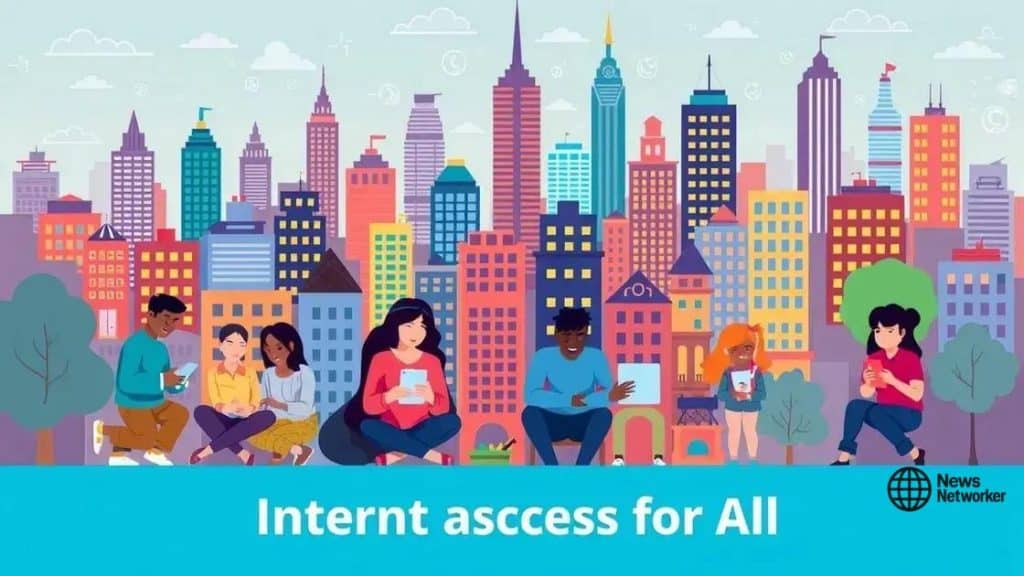Digital access as a public utility: a key for equality

Digital access as a public utility ensures everyone can connect to the internet, which is essential for education, healthcare, and economic opportunities, while innovative solutions and government policies are crucial to making this access universal.
Digital access as a public utility is more than just a buzzword; it represents a critical shift towards inclusivity. Have you ever wondered how a reliable internet connection can change lives? Let’s dive into the topic and explore its impact.
Understanding digital access as a public utility
Understanding digital access as a public utility is crucial in today’s interconnected world. It refers to the idea that access to the internet is a fundamental right, just like electricity or water. This concept drives home the importance of connectivity for all individuals, regardless of their background.
Many people take access to the internet for granted, but millions still lack reliable connections. It’s vital that society recognizes the need for digital access as a public utility.
What Does Digital Access Mean?
At its core, digital access encompasses the ability to connect to the internet and utilize its resources. This includes not only broadband connectivity but also the availability of devices and digital literacy. Without all these components, individuals face barriers to accessing essential services.
The Benefits of Recognizing Digital Access as a Public Utility
When digital access is treated as a public utility, several benefits can arise:
- Enhanced education opportunities for students.
- Improved access to healthcare services through telemedicine.
- Economic growth and development for communities.
- Bridging the digital divide between urban and rural areas.
These aspects highlight the importance of considering digital access a collective responsibility. When communities come together to support this initiative, everyone can thrive.
Investments in infrastructure are critical. Expanding fiber optic networks and wireless solutions can significantly improve connectivity. Policymakers need to prioritize these projects to ensure all residents have equal access to the internet.
The Role of Communities
Communities play a vital role in advocating for digital access. Local organizations can push for programs that facilitate access to technology and training. By partnering with local governments, they can create initiatives aimed at increasing digital literacy.
The future of digital access hinges on collaboration. It requires support from private, public, and nonprofit sectors to ensure everyone benefits. Educational institutions, businesses, and residents all have a stake in advocating for necessary changes. By working together, we can create a future where digital access is a reality for everyone, allowing them to soar to new heights.
The role of government in providing connectivity
The role of government in providing connectivity is essential. Governments have a responsibility to ensure that all citizens have access to the internet. This access is not just a luxury but a necessity in today’s digital age. By stepping in, they can help bridge the gap between those who have connectivity and those who do not.
Many countries have pledged to improve digital access for all. It’s about creating policies that support the expansion of internet infrastructure. When governments invest in connectivity, they help foster economic growth and social inclusion.
Key Responsibilities of the Government
Governments play multiple roles in enhancing connectivity:
- Developing infrastructure like fiber optic networks.
- Implementing policies for affordable internet services.
- Supporting initiatives that promote digital literacy.
- Collaborating with private sectors to expand reach.
These roles are vital to ensure no one is left behind. Access to the internet empowers citizens, giving them access to jobs, education, and health services.
Transforming the digital landscape starts with robust government action. For instance, through public-private partnerships, governments can effectively expand their reach. This allows the sharing of resources and expertise, which speeds up the process of connecting underserved areas.
Investments and Policy Frameworks
Investment is a cornerstone of any successful connectivity strategy. Governments must prioritize funding for telecommunications projects. This may include grants or subsidies to providers willing to service remote areas. It is also crucial to set up regulatory frameworks that encourage competition among providers.
By creating a competitive environment, customers benefit from lower prices and better service. This competition is essential to transform the digital economy. Additionally, clear policies can guide the sustainable implementation of connectivity initiatives.
Empowering local communities is another important aspect. Governments can work directly with community organizations to understand local needs. When locals have a voice in the planning process, those initiatives are more likely to succeed and be embraced by the community.
Innovative solutions to enhance accessibility

Innovative solutions to enhance accessibility in digital spaces are key to bridging the digital divide. These solutions aim to make the internet usable and accessible for everyone, especially those facing challenges. By incorporating creativity and technology, we can ensure that all individuals have the opportunity to connect online.
Many companies and organizations are exploring new ways to achieve this. Advances in technology allow for more adaptive tools that cater to various needs.
Assistive Technologies
Assistive technologies play a crucial role in enhancing accessibility. Here are some significant tools:
- Screen Readers: These read aloud the content displayed on the screen, benefiting visually impaired users.
- Speech Recognition Software: This technology helps users control devices through voice, making it easier for those with mobility challenges.
- Text-to-Speech Programs: These transform written text into spoken words, aiding individuals with reading difficulties.
- Alternative Input Devices: Tools like adaptive keyboards and mice provide various options for users with limited physical motion.
Each of these technologies addresses specific needs. By combining them, we can create a more inclusive digital experience.
Moreover, developers are increasingly focusing on creating websites and applications that are built with accessibility in mind. This includes using proper color contrasts, easy navigation, and clear layouts. Websites designed under these principles not only help users with disabilities but also improve the experience for all users.
Community-Driven Initiatives
Communities are also vital in promoting innovative solutions. Local organizations often create programs that teach digital skills. This helps individuals learn how to use assistive technologies effectively.
Crowdsourcing ideas from users can lead to new innovations that better fit community needs. By engaging with users directly, developers can understand the challenges people face and build better solutions. Involving users in the design process of new technologies ensures that products meet the real-world needs of communities.
Additionally, collaborating with advocacy groups can amplify these efforts. These organizations often have deep insights into the specific needs of individuals with disabilities. By working together, they can identify gaps and promote new solutions that enhance overall accessibility.
Challenges in making digital access universal
Challenges in making digital access universal are numerous and complex. While the goal is to ensure that everyone has reliable internet connectivity, several barriers hinder progress. Recognizing these challenges is essential for developing effective solutions.
Many regions still lack the necessary infrastructure to support high-speed internet. In rural areas, internet service providers often find it unprofitable to extend their networks.
Infrastructure Barriers
Infrastructure is a critical aspect of digital access. Some of the main issues include:
- Limited Broadband Coverage: Many rural and low-income areas struggle with inadequate service.
- High Installation Costs: The expense of laying down new cables or setting up wireless towers can be prohibitive.
- Geographical Challenges: Mountains, lakes, and other natural barriers can complicate infrastructure development.
- Insufficient Investment: Many governments and companies do not allocate enough funds to improve connectivity in underserved regions.
These infrastructure hurdles often result in a digital divide, leaving many people without access to essential services.
Affordability Issues
Another major challenge in achieving universal digital access is affordability. Many families struggle to pay for internet service, even when it is available. This problem is aggravated by:
- Low Income Levels: Families with limited resources prioritize basic needs over internet service.
- High Monthly Fees: Monthly charges for internet access can be too high for many households, especially when combined with other bills.
- Lack of Subsidies: In some regions, there are few or no programs to help low-income families afford connectivity.
These affordability issues prevent many from utilizing online resources needed for education, work, and healthcare.
Moreover, digital literacy remains a significant barrier. Even when access is available, people must know how to use it effectively. This is particularly true among older adults and those without formal education. Programs that promote digital literacy are essential to address this gap.
Culturally relevant training can help communities adapt to new technologies. Involving local leaders in education efforts can enhance the effectiveness of these programs.
The future of connectivity: a societal imperative
The future of connectivity represents a vital aspect of societal progress. As our world becomes more interconnected, ensuring that everyone has access to the internet is crucial for social and economic development. Without reliable connectivity, individuals and communities risk falling behind in an increasingly digital world.
Addressing this issue is more than just a technological challenge; it’s a moral one. Society must prioritize expanding access to all citizens, regardless of their location or income level.
Emerging Technologies
New technologies are playing a significant role in shaping the future of connectivity. Innovations include:
- 5G Networks: The rollout of 5G technology is enhancing speed and reliability, allowing for faster connections.
- Satellite Internet: Companies are launching satellites to provide internet access even in remote locations.
- Community Mesh Networks: Local communities are building their own networks to improve access where commercial providers are lacking.
As these technologies develop, they hold the potential to create more equitable access to online services, leveling the playing field for everyone.
Policy and Collaboration
To realize the vision of widespread connectivity, strong policies are necessary. Governments need to create frameworks that encourage investment in infrastructure. This includes:
- Incentives for Providers: Offering tax breaks or grants to encourage companies to expand their services.
- Public-Private Partnerships: Collaborating with private firms to leverage resources for infrastructure development.
- Community Engagement: Involving local populations in decision-making ensures solutions meet their needs.
Such collaborative efforts can help ensure that everyone, regardless of their circumstances, can benefit from reliable internet access.
The future of connectivity is not just about the technology but about creating a more inclusive society. By focusing on accessibility, we pave the way for future generations to thrive. This requires concerted efforts from individuals, governments, and organizations to turn the vision of universal access into reality.
FAQ – Frequently Asked Questions about Connectivity as a Public Utility
What is the importance of universal connectivity?
Universal connectivity ensures that everyone has access to the internet, which is essential for education, job opportunities, and healthcare.
How can new technologies improve access to the internet?
Emerging technologies like 5G and satellite internet can provide faster and more reliable service to underserved areas.
What role do governments play in enhancing connectivity?
Governments can create policies and funding programs to encourage infrastructure development and ensure that internet access is affordable for all.
How can communities contribute to improving internet access?
Communities can advocate for local needs, build their own networks, and engage in training programs to enhance digital literacy.





